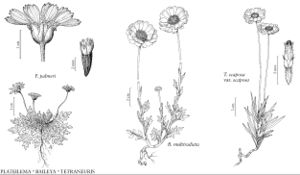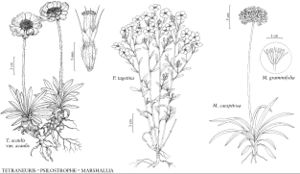Tetraneuris
Pittonia 3: 265. 1898.
Annuals or perennials, 2–50+ cm (perennials with ± branched, woody caudices). Stems 1–60, erect or ± decumbent, unbranched or sparingly branched distally. Leaves all basal, or basal-proximal, or basal and cauline; alternate; petiolate or sessile; blades (usually with distinct midribs) mostly oblanceolate to linear or filiform, sometimes lobed, ultimate margins usually entire, sometimes toothed, faces glabrous or ± hairy, eglandular or ± glanddotted. Heads radiate or discoid, borne singly or in paniculiform to corymbiform or fastigiate arrays. Involucres hemispheric to campanulate 6–20 mm diam. Phyllaries 11–60+ in 3 series (mostly spreading to erect in fruit, distinct, herbaceous; outer with or without scarious margins, abaxial faces ± hairy; mid usually same number as, alternating with, and similar to outer, almost always with ± scarious margins; inner narrower than others, margins scarious). Receptacles hemispheric to conic, shallowly pitted or smooth, epaleate. Ray-florets 0 or 7–27, pistillate, fertile; corollas (usually marcescent) yellow (laminae fan-shaped to oblanceolate, usually 3-lobed). Disc-florets 20–250+, bisexual, fertile; corollas yellow proximally, yellow or purplish distally, tubes shorter than cylindric to cylindro-campanulate throats, lobes 5, ± deltate. Cypselae ± obpyramidal, moderately to densely hairy; pappi persistent, of 4–8 usually aristate, scales. x = 15.
Distribution
North America, Mexico
Discussion
Species 9 (9 in the flora).
Here, strigoso-canescent refers to often silvery induments (hairs tightly appressed, relatively short, 1–1.5 mm) of Tetraneuris argentea and T. acaulis var. acaulis. Such induments contrast with lanuginose or sericeous induments (hairs spreading, ca 1.5–3 mm) in other taxa, including T. ivesiana and the other three varieties of T. acaulis.
Selected References
Lower Taxa
Key
| 1 | Annuals | Tetraneuris linearifolia |
| 1 | Perennials (with caudices) | > 2 |
| 2 | Caudices: branches not notably thickened distally; leaves all basal-proximal (not tightly clustered, internodes often evident) | > 3 |
| 2 | Caudices: branches notably thickened distally; leaves all basal or basal and cauline (basal leaves tightly clustered, internodes usually not evident) | > 4 |
| 3 | Stems erect; leaves sparsely to densely hairy, not woolly; Colorado, Kansas,Nebraska, New Mexico, Oklahoma, Texas | Tetraneuris scaposa |
| 3 | Stems erect or ± decumbent; leaves moderately to densely woolly; s Texas | Tetraneuris turneri |
| 4 | Leaves basal and cauline | > 5 |
| 4 | Leaves all basal | > 6 |
| 5 | Leaf blades ± densely strigoso-canescent | Tetraneuris argentea |
| 5 | Leaf blades glabrous or sparsely to moderately lanuginose to sericeous | Tetraneuris ivesiana |
| 6 | Ray florets 0 (leaves densely hairy, not strigoso-canescent; Yavapai County,Arizona) | Tetraneuris verdiensis |
| 6 | Ray florets usually 7–27 (if 0, leaves strigoso-canescent; widespread) | > 7 |
| 7 | Rays 14–27; pappus scales usually non-aristate; Ontario, Illinois, Ohio | Tetraneuris herbacea |
| 7 | Rays 7–15(–21); pappus scales aristate; North Dakota to Texas and west | > 8 |
| 8 | Leaves (midribs usually distinct) glabrous or usually sparsely, sometimes moderately or densely hairy (not strigoso-canescent or sericeous), gland-dotted; outer phyllaries 4–8, margins (0.3–)0.5–1.2 mm wide, usuallyconspicuously scarious | Tetraneuris torreyana |
| 8 | Leaves (midribs not very distinct) glabrous or ± hairy, often lanuginose, sericeous, or strigoso-canescent, eglandular or ± gland-dotted; outer phyllaries 6–12, margins 0–0.4 mm wide, sometimes slightly scarious | Tetraneuris acaulis |

